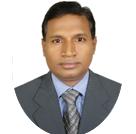Invited Speaker

Dr. Md. Abdul Karim
ProfessorLaboratory of Microbiology, Department of Botany, University of Dhaka, Bangladesh
Speech Title: Diversity and seasonal dynamics of bioaerosols in CAPITAL city
Abstract: Air pollution in capital city Dhaka has gone higher than Mexico-city and Mumbai killing thousands prematurely each year. According to the Department of Environment (DoE), the density of airborne particulate matter (PM) reaches 46 µg/m3 during December-March period, the highest level in the world.
Airborne microorganisms in the Dhaka city are extremely important because of the economic and health problems they may cause. Sneezing, talking, laughing, falling hair, contaminated paper and coined currency exchange, using soiled laboratory coats, as well as shedding from hands and arms contributed to the microbial contamination in the atmosphere. Monitoring the microbial population in the atmosphere of Dhaka city during whole year is important for discovering possible emerging sources of contamination. For this reason Dhaka city, where public gathering is high is selected for the present work to study the bacterial abundance in air that could be a causal agent of different human diseases.
The aim of this study was to analyze the composition of the bacterial community in the air of Dhaka city using a culture-dependent plate exposure technique and air sampling with filter. The 16S rRNA genes were amplified directly from the isolates with universally conserved and bacteria-specific rRNA gene primers. The PCR products were screened by restriction fragment length polymorphism and representative rRNA gene sequences were determined and sequenced. Seven air-sampling sites were taken from outdoors and various work environments including indoor airport, market, bas station, railway station, lunch terminal, hospital and Curzon hall area. Exposed plate method and air sampler were used for sampling at the breathing zone about 1.5 m above the ground level and Meteorological factors such as relative humidity, temperature, and light intensity were measured by portable data logger.
The relative humidity was 34 - 66 %, and temperature 17.3 - 43ºC, and light intensity varied between 335 and 19380 Lux. An average value of 2750 bacterial CFU/m3 was found at Dhaka city in different seasonal time. In Curzon Hall area 1661 bacterial CFU/m3, in Dhaka medical college and hospital 1811 bacterial CFU/m3 were found while, in Kamlapur railway station 4284 CFU/m3 was found, cause in the highly populated and traffic crowded area.
A total of 58 isolates were selected for further study on the basis of their colony morphology and frequency of presence onto the agar plate. All isolated bacterial strains were Gram-positive and under 12 genera viz. Bacillus (63.79 %), Staphylococcus (6.89%), Planococcus (6.89%), Kocuria (5.17%), Micrococcus (3.45%), Planococcaceae (1.73%), Janibacter (1.73%), Acinetobacter (1.73%), Arthrobacter (1.73%), Microbacterium (1.73%), Exigubacterium (1.73%) and Deinococcus (1.73%). The distribution of predominant airborne bacteria varied greatly between different stations and seasons and was limited by environmental parameters, as well as human activities. Highest bacterial diversity was found in the air in July 2011 during the study.
These results highlight the difficulty in understanding and interpreting the microbial structure of these communities, and consequently, more attention should be paid to the conservation of our city environment.
Key words: Bioaerosols, seasonal variation, capital city
Biography: Dr. Md. Abdul Karim is a Professor and Principal Investigator of bioremediation of wastewater and seasonal dynamics of bioaerosols in the capital city in the Environmental Microbiology and Biotechnology, Department of Botany, University of Dhaka, Dhaka 1000. He earned his PhD at Ehime University, Japan. Research in his lab focuses on understanding of how to evaluate and control microbial activities in eutrophic environments. His current project includes 1) Bioremediation of eutrophic environments, 2) seasonal variation of bioaerosols, 3) Characterization of hydrocarbon and textile dye degrading bacteria, 4) Isolation and characterization of multidrug resistant bacteria from environmental samples and hospital wastes; and 5) Understanding of how pathogenic bacteria can survive longer period in adverse condition in association with other microorganisms and their interrelationship. He has supervised over 27 postgraduates and PhD. He has published 65 peer-reviewed papers in microbiology, author of 12 book chapters and 3 research books.
Prof. Karim is an executive editor of Bangladesh Journal of Botany (BJB) and member of editorial board of Journal of Asiatic Society of Bangladesh, Science; Science International; World Journal of Applied Sciences; International Journal of Biosciences; Journal of Biodiversity and Environmental Sciences; Microbiology Research International, Journal of Biological Sciences. He was awarded by University Grants Commission in the recognition of his outstanding performance in his field.
